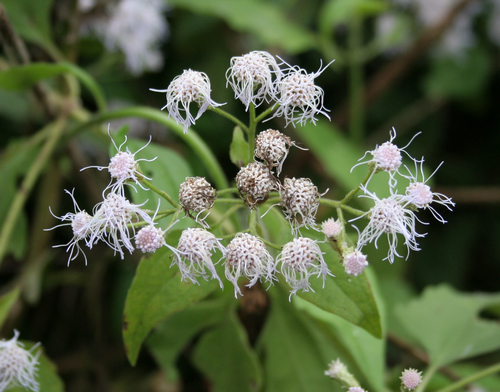Chromolaena odoratahas become one of the most invasive species in southern China. Many non-mutually exclusive mechanisms for its invasions have been studied. However, no previous studies have explored the importance of the evolution of increased competitive ability and innate competitive advantages in a parallel study.
Prof. Feng Yulong, together with his students of XTBG and other colleagues, conducted a study to test the evolution of increased competitive ability (EICA) hypothesis and the novel weapons hypothesis (NWH) by comparing the performances of C. odorata plants collected as seeds from different populations in the native and nonnative ranges and then grown in common gardens in Mexico and China. They compared interactions between C. odorata and Eupatorium japonicum, Eupatorium stoechadosmum, and Eupatorium heterophyllum, which are native to China, and Eupatorium ligudtrinum, which is native to Mexico.
They asked whether C. odorata plants from populations in the nonnative range differed in size, competitive ability, and herbivore defense from plants from the native range; and whether species from the nonnative range of C. odorata differed in susceptibility to the effects of C. odorata leaf leachates from species from the native range of C. odorata.
Their study found that C. odorata plants from the native range demonstrated superior competitive ability against species native to the range it invaded, showing innate competitive advantages. Also, native species from the invasive range in China were more vulnerable to allelochemicals presumably present in the leachate made from C. odorata than natives from the native range in Mexico, which is consistent with the NWH. Plants from invasive populations of C. odorata demonstrated a superior competitive ability and inferior defensive ability against natural enemies compared with plants from native populations, which is consistent with the EICA hypothesis.
The research results indicated that the three factors, i.e. evolution of increased competitive ability, innate competitive advantages, and novel biochemical weapons might act in concert to promote invasion by C. odorata, and emphasized the importance of exploring multiple, non-mutually exclusive mechanisms for invasions.
The study entitled “The evolution of increased competitive ability, innate competitive advantages, and novel biochemical weapons act in concert for a tropical invader” has been published in New Phytologist, (2013) 197: 979–988, doi: 10.1111/nph.12071

Chromolaena odoratahas (Image by ZHENG Yulong)

